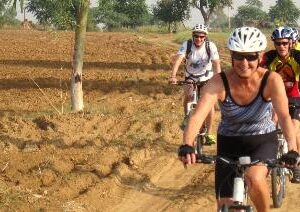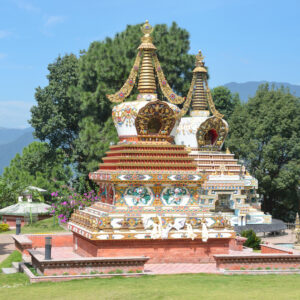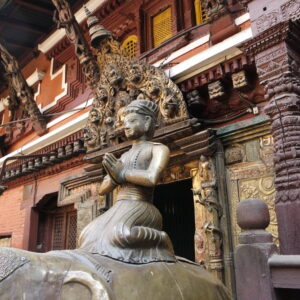Day 1 ARRIVE KATHMANDU
Meals: None
It is a panoramic thrill flying into Kathmandu on a clear day. The views of snow-capped mountain peaks sprawling down below you are almost ecstatic, beginning a whole chain of memorable experiences that stay with you for a long, long time. A representative and driver from Yeti Holidays will meet you at the airport and escort you to your designated hotel. The representative will help you check into hotel. At the hotel you will be briefed about your daily activities.
Check In and Overnight at Hotel Shambala.
Day 2 OPTIONAL MOUNTAIN FLIGHT/ SIGHTSEEING TOUR
Meals: Breakfast.
One of the must-see landmarks of Nepal is, of course, the highest peak in the world – Mount Everest. An awe-stricken silence comes close to matching the experience of a mountain flight. For one hour, you’ll fly over the Eastern Himalayan Ranges of Nepal where some of the highest peaks in the world including Mt. Everest lie for a surreal feeling as you come face to face with the world’s tallest and most enigmatic of Mountains. Even those visitors who like the rigors of a trek won’t miss the opportunity to “conquer” the mountains in one stunning swoop.
After breakfast at the hotel commence the sightseeing tour of Kathmandu city, Swayambhunath and Patan city.
KATHMANDU DURBAR SQUARE
The durbar square with its arrays of temples, courtyards, monuments and the ancient palaces of the former Nepali Royals is located in Basantapur in the heart of Kathmandu city, the country’s capital. Chief attractions here include Hanuman Dhoka Royal Palace, the magnificent Taleju Temple towering more than 40 meters; Kumari Ghar, the residence of the Living Goddess, Kumari; the temple of Ashok Vinayak dedicated to lord Ganesh (elephant headed deity), and Kal Bhairav, the God of Wrath. There is a giant pagoda of ‘Kasthamandap’, a structure which is said to have been built out of a single tree. The name of the capital ‘Kathmandu’ is said to be actually derived from ‘Kasthamandap’.
Note: The recent earthquake completely destroyed Kasthamandap and some temples in the durbar square premise. Hanumandhoka palace complex and Kumari Ghar also fall amongst the affected ones.
SWAYAMBHUNATH
Said to be around 2000 years old, this Buddhist Stupa sits atop a hillock 02 kilometres west of Kathmandu overlooking the valley. The oldest written reference to the stupa dates from the 5th century, but it could have existed much earlier. Moreover, a legend has it that the stupa evolved spontaneously at the time of the Kathmandu valley’s creation.
Swayambhunath is famously known as the ‘Monkey Temple’ owing to the presence of a large number of monkeys around the area.
PATAN DURBAR SQUARE
Located 5 km southeast of Kathmandu, the Patan city popularly known as ‘the city of artisans’ accommodates a magnificent square housing the palace buildings of the then royals, artistic courtyards and graceful pagoda temples – a display of Newari architecture that had reached its pinnacle during the reign of the Malla kings. It is filled with wood and stone carvings, metal statues, and ornate architecture, including dozens of Buddhist and Hindu temples, and over 1200 monuments.
Note: The recent earthquake has destroyed few temples in the durbar square premise; several structures have sustained minor damages.
Overnight at Hotel.
Day 3 DRIVE TO LAPSI PHEDI AND TREK TO CHUKI BHANJYANG [1950M/2-3 HRS].
Meals: Breakfast, Lunch and Dinner.
After breakfast at the hotel drive to Lapsi Phedi, located around 20 kilometers from Kathmandu, is one of the most scenic spots near Kathmandu and is renowned for its spectacular view of the Himalayas and famous tea garden. The fabulous area features attractions ranging from beautiful alpine scenery to the magnificent Himalayan Panorama.
After reaching at Lapsi Phedi trek start to Chuki Bhanjyang. During the initial few minutes, pass many village houses and lodges before dropping off the ridge on the Kathmandu valley side to enjoy the mountain views which includes Melungtse (7131m) and Gauri Shanker (7146m), with the Jugal himal – Ganchempa (6397m), Dorje Lhakpa (6980), and Phurbi Ghyanchu (6722m) and further to the north lies the Bhairavkund and Gosainkund lakes area, behind which rises Langtang Lirung (7245m). The vegetation here is somewhat scarce but reforestation efforts in recent years has begun to produce a positive impact. After a steep climb away from the village, earn good views of the valley and the still almost medieval town of Shanku nestling at the east end of the Kathmandu valley.
A series of dwellings, mostly inhabited by Tamangs, lead to the village of Chauki Bhanjyang (1950m). During the winter months, when the weather is clear, the mountain views are superb. Immediately to the north lies the valley of the Indrawati River with the ridge to the east leading from Chatara to the Panch Pokhari (five lakes) area below Tilmans Col which crosses into Langtang and beyond.
Overnight at Local Lodge.
Day 4 TREK TO BURING BHANJYANG [2438M/5-6 HRS].
Meals: Breakfast, Lunch and Dinner.
The trail climbs west up the line of the Manichaur Danda (ridge) for about an hour and then drops onto the north side of the ridge, following the well-defined path besides a strong rock built wall which aims to protect or define the higher slopes of the hill.
Another half hour on, the trail leads the wall and enters more broken jungle country. Stop for lunch at a beautiful natural campsite. In spring, wild yellow raspberry bushes offer refreshment and on a clear day, the mountain views are some of the best available. Tamang settlements are scattered across the terraced hillsides, with the Sindhu Khola (river) valley immediately below.
Another 2 to 2.5 hours walk along the flank of the hill leads to Chisapani (2194m) and the meeting with the main route from Sundarijal to Helambu. Climb steeply up the north slope, past Chepu Bhanjyang to Buring (2438m) where a couple of houses offer tea amidst beech and Rhododendron forest.
Overnight at Local Lodge.
Day 5 TREK TO SHIVAPURI [2560M/5-6 HRS].
Meals: Breakfast, Lunch and Dinner.
The route leads west through wood on the south side of the ridge, with fine views across the Kathmandu valley. After half an hour, a Bhanjyang (crossing point) is reached in an open area, with a Chautara on which are two Churungs (small Buddhist chortens). Another half hour of easy walking is followed by a steep ascent through oak and rhododendron. The climb eases and with no human habitation on this stretch, the forest is thick and lush with rhododendron in flower up to late April. A natural well near a clearing in the forest makes an ideal lunch stop.
Overnight at Local Shivapuri Heights Cottage.
Day 6 IN SHIVAPURI.
Meals: Breakfast, Lunch and Dinner.
After breakfast visit Local Village.
Shivapuri is the ninth national park in Nepal and was established in 2002. It is located in the country’s mid-hills on the northern fringe of the Kathmandu Valley and named after Shivapuri Peak of 2732 m (8963ft) altitude. The park includes some historical and religious sites, and a popular hiking route for local people and tourists.
Shivpuri is described in the Skanda Purana’s Nepalmahatmya as “auspicious place of Lord Shiva, filled with Shivalingams”
Overnight at Local Shivapuri Heights Cottage.
Day 7 FINAL DEPARTURE.
Meals: Breakfast.
We ensure that you will leave Kathmandu with cherishing memory and an experience of a lifetime. Our representative will drive you to the airport in time for your flight back home.





Reviews
There are no reviews yet.